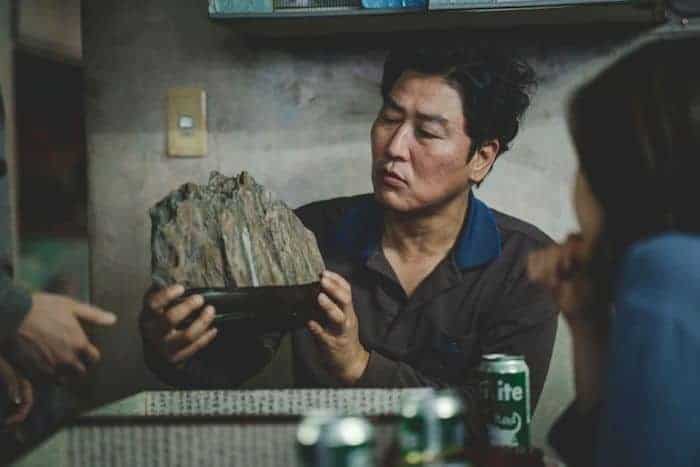
by Christina Waters | Nov 15, 2019 | Art, Home |
Parasite, the new film by Korean auteur director Bong Joon Ho, is not only gorgeous to look at, it presents a harrowing satire on the state of class inequity in the 21st century. It’s hard to think of a recent film that packs this much metaphorical power. Set in Korea in the midst of a Dickensian disparity of wealth—the Kims live in basement squalor, the Parks live in upscale serenity. But it could be anywhere in the first world. It is here, right now, and that very fact provides the razor edge of recognition audiences feel in response to this darkly comic/existential romp that snatched the Cannes Festival’s Palme d’Or away from Quentin Tarantino (See my review of Tarantino’s “Once upon a time in Hollywood”.)
Parasite is a tale told through two families: the luckless, unemployed Kim Family headed by the extraordinary Kang-Ho Song as the father, Kim Chung-Sook as his wife, Choi Woo-Shik as teenaged son “Kevin” and Park So-Dam as his crafty hacker sister “Jessica. Determined to claw their way out of their ghetto squalor, the Kims scheme their way (I won’t spoil it) into the lives of the wealthy Park Family, led by Cho Yeo-jeong as the naive, lovely Mrs. Park and Lee Sun Gyun as style-conscious CEO Mr. Park.
 Before you know it the Kims, who’ll literally do anything to make money, manage to insinuate themselves into the heart of the Park’s splendid household. It is a symbiotic ecosystem made in the hellishly brilliant imagination of this director.
Before you know it the Kims, who’ll literally do anything to make money, manage to insinuate themselves into the heart of the Park’s splendid household. It is a symbiotic ecosystem made in the hellishly brilliant imagination of this director.
[Above we find the resourceful Kim siblings finding the best signal from their neighbor’s wifi right above the toilet.]
Mr. Kim becomes Mr. Park’s driver, Mrs. Kim is the new Park housekeeper after cleverly managing to get the former one fired (the scenes here are laugh out loud funny). The son becomes tutor (and lover) to the Park’s daughter, and his sister poses as an art therapist for the Park’s young son, who is obsessed with American Indians.
 The house itself is a key player in what will reveal itself to be Bong’s sly-handed tale of social inequity. An architectural masterpiece (designed by director Bong and made especially for the film) the sleek modernist house is laid out in interlocking levels. The living room’s enormous wall of glass overlooks an oasis of green lawn bordered by a manicured hedge.
The house itself is a key player in what will reveal itself to be Bong’s sly-handed tale of social inequity. An architectural masterpiece (designed by director Bong and made especially for the film) the sleek modernist house is laid out in interlocking levels. The living room’s enormous wall of glass overlooks an oasis of green lawn bordered by a manicured hedge.  This hermetic world insulates the Parks from any unsightly social reality and makes a painful contrast to the mess and chaos of the Kim’s basement apartment. Most importantly to the director’s storytelling, the house also contains a secret passage into yet another domain—and a ghastly secret buried deep within the heart of lavish wealth.
This hermetic world insulates the Parks from any unsightly social reality and makes a painful contrast to the mess and chaos of the Kim’s basement apartment. Most importantly to the director’s storytelling, the house also contains a secret passage into yet another domain—and a ghastly secret buried deep within the heart of lavish wealth.
Bong’s social commentary is never heavy handed, but it spares no one.
How this secret is discovered, what it contains, and where its layered metaphors lead are the elements driving a tsunami of loss, compassion, violence, joy, and ultimately a fairytale ending.
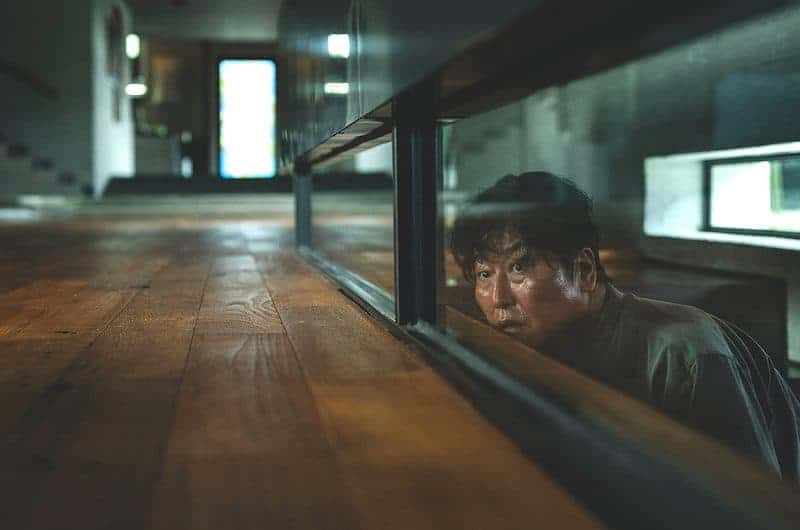
Parasite is powered by poetic cinematography, scored with Western classical music (another edgy dig at Korean social pretentions) and acted by a cast of brilliant players as capable of slapstick as heartbreak. I laughed my way through this film, even during its most terrifying scenes. The two families and the social codes they embody are turned inside out more than once, and never in predictable ways. All the actors are memorable, but especially lead player Kang-Ho Song, Mr. Kim [above], a frequent Bong collaborator. His broad face is roadmap of dashed dreams. As expressive as any Willem Dafoe, a savage/tender mirror reflecting Mr. Kim’s transformation—and his realization that his family’s larceny has triggered untold psychic damage. Nothing in Mr. Kim’s life has ever worked out, and Song’s face ultimately reveals despair on a Kierkegaardian scale. A great actor in a part worthy of his astonishing gifts.
Near the end of Parasite we find that just desserts are the main course of an outdoor birthday party for the spoiled Park son.  And once the shocking visual pyrotechnics have cooled down, the film draws to a haunting, eloquent close a la Charles Dickens. Desperate and ephemeral dreams, of the sort that reveal how much the rich and the poor are mutually bound in a slow dance of need, greed, hypocrisy, and desire.
And once the shocking visual pyrotechnics have cooled down, the film draws to a haunting, eloquent close a la Charles Dickens. Desperate and ephemeral dreams, of the sort that reveal how much the rich and the poor are mutually bound in a slow dance of need, greed, hypocrisy, and desire.
Parasite is a stunning cinematic fable, brilliant in every way, and for my money….unforgettable.

Once Upon a Time…in Hollywood
by Christina Waters | Aug 4, 2019 | Home |
The title of Quentin Tarantino’s ninth film is significant. Once Upon a Time . . . in Hollywood. This is how fairytales begin: once upon a time. Something to keep in mind as you watch this juicy look in the rearview mirror at the days when Hollywood films were long on cleavage, polyester, and cowboys with sideburns.

Acid rock competed with the Beatles, Beach Boys and Sly & the Family Stone. Everybody smoked. And marijuana was in its first ascendance. Let me repeat that—everyone smokes in this film. All.The.Time. Which of course was the way it was. Watching the actors smoke amounts to a risk-free contact high.
A lot of things happened in the summer of 1969, and setting foot on the moon was only one of them.
In Hollywood we meet fading TV star Rick Dalton (Leonardo diCaprio) and his faithful stunt double Cliff Booth (Brad Pitt). Dalton, once the star of his own series, is now reduced to picking up work as the bad guy in B grade Westerns and is desperate to keep his career from sinking further into the toilet. He’s lost his license (too many DUIs) and has to be driven by Booth, who is also his best buddy and all-around gofer. They cruise the canyons in Dalton’s 1966 pale yellow Cadillac deVille down the winding roads like a couple of Neal Cassidys, radio blasting, six-pack at the ready.
But things are changing in the movie industry, as the actor, his stuntman, and director Tarantino all mourn. TV is winning, producer’s agendas have become good guy/bad guy deal-making, and it’s no longer the Golden Age of John Wayne and film noir detective thrillers. Dalton needs some serious career counseling, which he gets from a hustler agent Marvin Schwarz, Al Pacino in a delightfully woeful wig. Kid, he’s told, you’re taking guest slots in too many Westernsas the bad guy, the guy who always gets beaten in the gun fight. You keep getting beaten, and people will begin to see you as a loser.
Dalton gets it, and starts examining his life as a potential has-been, while the unflappable Booth tries to keep his boss’ spirits up.
 It’s worth noting that Tarantino’s loveletter to an America gone (and which existed only for some) also grieves for values currently in decline in 21st century America. In a recent op-ed piece Maureen Dowd observed that “Brad Pitt’s character reflects many values that America once proudly stood for: toughness without belligerence, charm without smarminess, loyalty without question.” And it’s Pitt’s performance that shines most brightly, both in terms of relentless can-do spirit and in terms of living large with a minimum of dishonesty.
It’s worth noting that Tarantino’s loveletter to an America gone (and which existed only for some) also grieves for values currently in decline in 21st century America. In a recent op-ed piece Maureen Dowd observed that “Brad Pitt’s character reflects many values that America once proudly stood for: toughness without belligerence, charm without smarminess, loyalty without question.” And it’s Pitt’s performance that shines most brightly, both in terms of relentless can-do spirit and in terms of living large with a minimum of dishonesty.
You’ll be thinking about that performance, and its implications—and the contrast with the world as it senselessly plays out today—for a long time after the credits finish rolling. (And don’t miss the credits!)
Great details from the get-go. Dalton lives in the big house, a spacious pad with a pool on Cielo Drive up in the hills next to a palatial gated compound rented by Dalton’s idol director Roman Polanski, and his new wife, actress Sharon Valley of the Dolls Tate (Margot Robbie). Already you’re beginning to see where Tarantino might be going with this film, but keep in mind—it’s a fairytale.
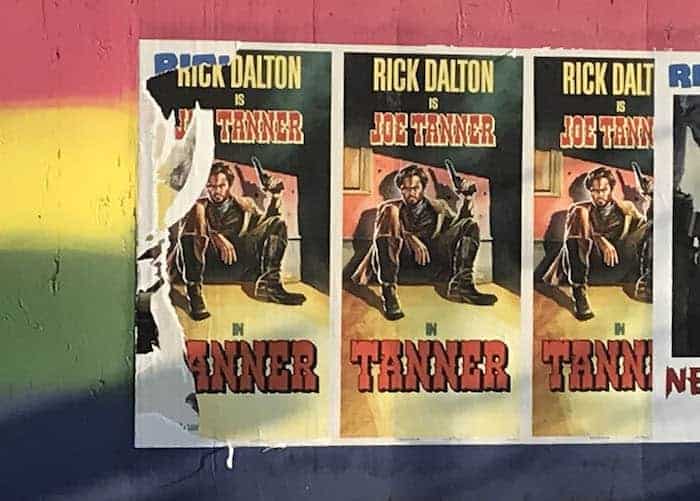 After the end of long days on the set—days in which Dalton is getting fewer parts, and Booth is given fewer stunt gigs—Booth drives Dalton back to Cielo Drive in the Caddie, and then hops into his own battered Karmann Ghia for the long commute back to his airstream trailer in Van Nuys.
After the end of long days on the set—days in which Dalton is getting fewer parts, and Booth is given fewer stunt gigs—Booth drives Dalton back to Cielo Drive in the Caddie, and then hops into his own battered Karmann Ghia for the long commute back to his airstream trailer in Van Nuys.
Tarantino gives Pitt a rare chance to stretch. As Booth he radiates easy confidence, part good-humored ex-Vietnam Vet in tight jeans and part highly-trained martial arts expert whose radar is always humming in the background. This is a man who enjoys life, the downs as well as the ups, and his scenes with his beloved pitbull Brandy, are priceless. Pitt is mesmerizing, and not simply because in one scene, a hot day and he’s up on Dalton’s roof checking the TV antenna, he’s forced to strip off his shirt. I’m thinking of writing Tarantino a “thank you” note for that one shot alone. Not since he debuted way back in Thelma and Louise has Pitt looked this good. Capable of serious danger, he keeps his easy grin. Until he doesn’t.
DeCaprio is just as good, and I’ve never been a fan. Rehearsing his scenes in a new Western, DeCaprio’s Dalton is an explosion of hungover rage, humiliation, irritation, and bad luck. When he blows his lines and needs to take a break, he returns to his trailer on the set and proceeds to throw an epic fit of self-loathing, breaking everything in sight and swearing off liquor just long enough to get the scene right when he goes back for another take. And by the way, when he does, he’s spellbinding.
Most of this movie relies upon the rapport between these two actors. Effortless together, they create an easy rider ambience (DeCaprio’s voice is vintage Jack Nicholson), yet their characters have different goals. Booth just wants to get by. Dalton just wants to maintain a public image.
But of course, Once Upon a Time…in Hollywood, is also about something else that happened in August of 1969.
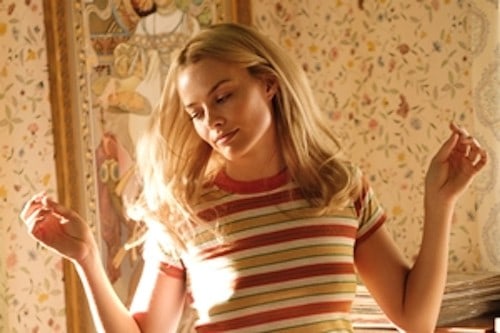 So we meet Sharan Tate while her husband is out of the country, and she and her former boyfriend (now constant companion) Jay Sebring (Emile Hirsch) go out to all the parties. Tarantino’s portrait of Tate is as a glowing, all-American beauty enchanted by her own good fortune, good looks, and not much else. She flits, and dances, and skips through Westwood Village, even stopping in a theater to catch a screening of her latest film, squealing with excitement at the sight of herself on the screen. The film’s soundtrack, and settings, plunge us into a made-for-Hollywood fantasy of Hollywood itself. Over-the-top eye candy. Just enjoy it. Meanwhile, Tarantino is an adolescent indulging his own fantasies, of Hollywood, of the 60s and of what might have happened one fateful night.
So we meet Sharan Tate while her husband is out of the country, and she and her former boyfriend (now constant companion) Jay Sebring (Emile Hirsch) go out to all the parties. Tarantino’s portrait of Tate is as a glowing, all-American beauty enchanted by her own good fortune, good looks, and not much else. She flits, and dances, and skips through Westwood Village, even stopping in a theater to catch a screening of her latest film, squealing with excitement at the sight of herself on the screen. The film’s soundtrack, and settings, plunge us into a made-for-Hollywood fantasy of Hollywood itself. Over-the-top eye candy. Just enjoy it. Meanwhile, Tarantino is an adolescent indulging his own fantasies, of Hollywood, of the 60s and of what might have happened one fateful night.
 The scenes of the Spahn Movie Ranch, owned by an old friend of Booth’s, where the Manson Family has decamped feel chillingly authentic. Nothing short of Sergio Leone-meets-David Lynch is the surrealistic atmosphere of Pitt accidentally meeting the Manson family for the first time. When he returns from checking in on old man Spahn he discovers that his car tire has been flattened, and in “persuading” the bad guy to fix the tire he’s damaged, we first see what stunt man Booth is truly capable of. It’s frankly shocking, all the more so since it’s the warm persona of Brad Pitt’s character that suddenly reveals what’s beneath.
The scenes of the Spahn Movie Ranch, owned by an old friend of Booth’s, where the Manson Family has decamped feel chillingly authentic. Nothing short of Sergio Leone-meets-David Lynch is the surrealistic atmosphere of Pitt accidentally meeting the Manson family for the first time. When he returns from checking in on old man Spahn he discovers that his car tire has been flattened, and in “persuading” the bad guy to fix the tire he’s damaged, we first see what stunt man Booth is truly capable of. It’s frankly shocking, all the more so since it’s the warm persona of Brad Pitt’s character that suddenly reveals what’s beneath.
Pitt, and the character he plays, reveal the secret heart of Tarantino’s film, while the astonishing retrofitting of Hollywood Boulevard by set decorator Barbara Ling plunges us into the archetypal neon, eye-popping façade of Tinsel Town. It is the tension as well as the blurring of that buried rage and superficial sunshine that plays so powerfully in this way-too-long film by Tarantino who, as auteur, can do what he damn well pleases.
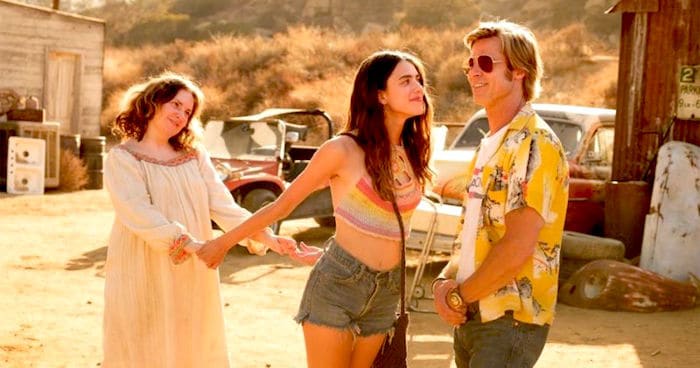 The entire film taxes the viewer’s patience as much as it strains even fairytale credulity. But there are scenes to savor that make the experience well worth while (keep in mind Pitt’s abs).
The entire film taxes the viewer’s patience as much as it strains even fairytale credulity. But there are scenes to savor that make the experience well worth while (keep in mind Pitt’s abs).
Back at the Airstream, Cliff Booth opens the first of many cans of beer, then carefully opens two super-sized cans of dog food for his pitbull Brandy. Wonderful timing in Booth’s kitchen ritual as we watch the entire can of glistening brown dog food slurp into Brandy’s chow bowl. Only after Brandy has been told she can eat does Booth sit in front of the TV with his Kraft macaroni and cheese—still in the pan from the stove—and watch an episode of “FBI” on his tiny black and white TV.
And there’s an acting cameo at the Spahn Ranch, which I won’t reveal, also worth the price of admission. And while Robbie is fine as Tate, though not given much more than Breck commercial prancing around to do, it’s the bond between the actor and his double, the boss and the hired hand that makes the film sing. The stunt man actually has lived the life that his buddy, the actor, can only play on the screen
Finally, this is Tarantino, so yes, you can expect to wince during the last half hour of the film. But not for the exact reasons you’re expecting. Pulp Fiction remains the director’s masterpiece, but to watch two fine actors at the top of their game having a great time—as actors and as characters—Once Upon a Time is must-see.
I promised myself I wouldn’t deliver any spoilers, so I have to stop here. There’s tons of semiotic minutiae to dissect. Have fun with it. Especially if you actually remember 1969—this film won’t disappoint.
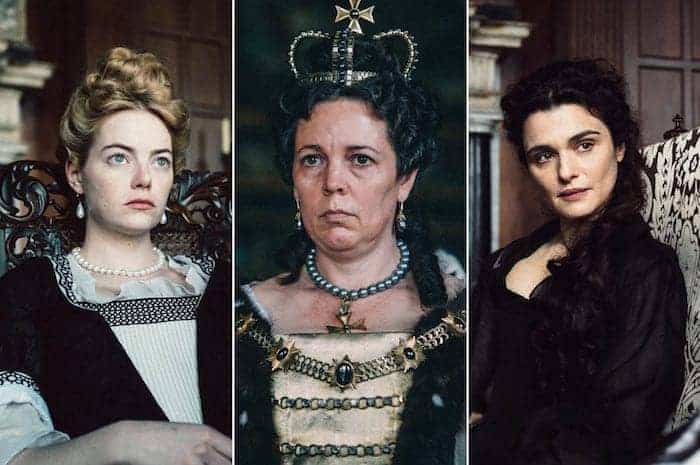
Oscar Wrap-up!
by Christina Waters | Feb 18, 2019 | Home |
The Duelling Duo Christina Waters and Lisa Jensen add their final two cents (ha! that’ll be the day) to this year’s nominations. Read on!
CW: Best Original Screenplay Well here again I didn’t see one of the nominees, First Reformed, but based on the films I did screen I’d say that Vice was the sassiest, The Favourite was the most eccentric, and Green Book the most appealing. BUT, I’m thinking that Roma will take it based upon the care with which Cuaron’s memory revealed the many tiers of the class structure and family realities in Mexico City in the 60s. This may be where Roma was at its best.
LJ: And I’m at a disadvantage for not having seen Vice. I did see First Reformed, which unspooled as a taut, tightly-wound tirade against modern disconnection, as only veteran Paul Schrader (Taxi Drivr; Raging Bull) can deliver. The Academy might go for it, in honor of Schrader’s sheer, stubborn longevity. I don’t think Roma’s greatest strength is in its scriptwriting, as much as in the scope of its storytelling, but if it wins Best Picture it will likely win this prize too. By the way, of the Adapted Screenplay nominees, I only saw is Can You Ever Forgive Me, so I don’t feel qualified to weigh in on that category.
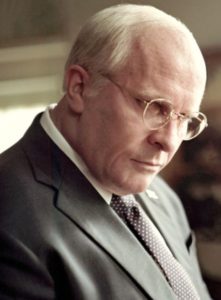 CW: Makeup and Hair: Well it HAS to be Vice for its miraculous transformation of some fine actors—especially Steve Carell, Christian Bale and Sam Rockwell—into some of the highest profile politicos in the 20th century.
CW: Makeup and Hair: Well it HAS to be Vice for its miraculous transformation of some fine actors—especially Steve Carell, Christian Bale and Sam Rockwell—into some of the highest profile politicos in the 20th century.
LJ: Agreed! Transforming Christian Bale into Dick Cheney seems more like a job for the CGI department, but they pulled it off with cosmetic wizardry alone!
CW: Costume Design: Wish I’d seen Black Panther because I have a strong feeling that Ruth E. Carter’s costumes were bravura. But since I didn’t, I’ll take the foppish decadent crowd of 18th century dandies brilliantly costumed by Sandy Powell for The Favourite.
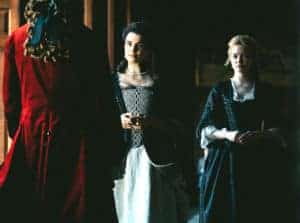 LJ: Black Panther all the way for me. The rich Tribal-Meets-Techno vibe created by Ruth E. Carter was eye-popping, fun, and so smart! Whereas, The Favourite costumes looked slightly fake to me, like costumes you make for the Renaissance Faire with store-bought materials like rick-rack instead of elaborate period embroidery. But, intentionally fake, like everyone in the movie was in on a big joke, and they were all sniggering behind their fans at the absurdity of it all.
LJ: Black Panther all the way for me. The rich Tribal-Meets-Techno vibe created by Ruth E. Carter was eye-popping, fun, and so smart! Whereas, The Favourite costumes looked slightly fake to me, like costumes you make for the Renaissance Faire with store-bought materials like rick-rack instead of elaborate period embroidery. But, intentionally fake, like everyone in the movie was in on a big joke, and they were all sniggering behind their fans at the absurdity of it all.
CW: Lisa, Lisa, Lisa! Those costumes could have rolled right out of the history books they were so bloody exact. The film itself might have seemed absurd, but the costuming smacked of authenticity, to me.
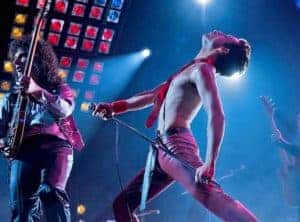
CW: Sound, there are actually two sound awards, one for editing—and here I’ll take Bohemian Rhapsody, although I was intrigued by the sound in Roma; And there’s Sound Mixing. Ditto Bohemian Rhapsody. Seriously, the Freddie Mercury & Queen rockumentary offered up a lavish tsunami of prime ripping, peeling, screaming rock’n’roll. The sound was one of the most potent characters in the film and moved us in, out and upwards through the mercurial (sorry) journey of this tragic rock icon.
LJ: I’m with you on Bohemian Rhapsody for Sound Mixing: getting all that iconic music to blend so perfectly in and out of the narrative was quite a feat. But let me play devil’s advocate in the Sound Editing category, where one of the nominees is A Quiet Place— a vaguely futuristic, dystopian thriller in which a family must learn to hide in silence when stalked by deadly creatures with acute hearing. No, I didn’t see it (or hear it), but it sounds like the kind of stunt movie Academy voters might take note of.
And that’s it for this year’s Oscar predix! Don’t forget to tune in on Sunday Febnruary 24 to see how it all ends up!
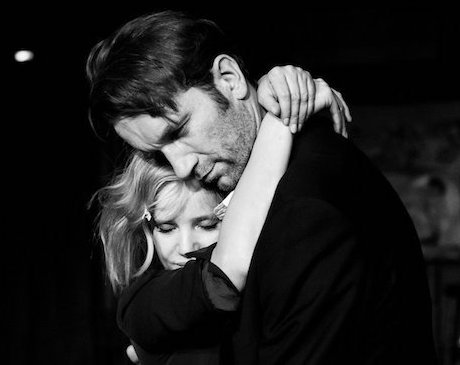
Cold War: Love in Black & White
by Christina Waters | Feb 16, 2019 | Home |
In real life, an Impossible love affair is agony. But in cinema it’s the stuff of enchantment. Cold War is the captivating odyssey of such a love. Seductive music and obsessive love perfume this gorgeous black and white loveletter to director/screenwriter Pawel Pawlikowski‘s native Poland, captured with stark tenderness in this Oscar-nominated elegy.
A passionate pianist and a duplicitous singer fall desperately in love from the very start, and the film—shot in Poland, Croatia, and Paris— follows the vertigo of their searing connection. Their struggle to find a world they can live in mirrors the tensions besetting post WWII Poland, whose broken dreams form the background metaphor for the protagonists’ love.
A perfect film, Cold War is Polish director Pawlikowski’s loveletter to his native land, its traditions, its grim years during the Soviet era, and to his parents who provided the inspiration for the volatile and charismatic main characters.
 The lovers first make an electrifying connection when the young blonde Zula auditions for a Polish folksong and dance troupe, Mazurk, training to begin a tour of Eastern European cities. Wiktor (Tomasz Kot) is one of the music instructors, and when he hears Zula (Joanna Kulig) audition he is immediately drawn to her bright energy. She is as sensuous as he is brooding. But as he quickly learns, she has a checkered past, and uses the musical ensemble as a means of escape into a more exciting life.
The lovers first make an electrifying connection when the young blonde Zula auditions for a Polish folksong and dance troupe, Mazurk, training to begin a tour of Eastern European cities. Wiktor (Tomasz Kot) is one of the music instructors, and when he hears Zula (Joanna Kulig) audition he is immediately drawn to her bright energy. She is as sensuous as he is brooding. But as he quickly learns, she has a checkered past, and uses the musical ensemble as a means of escape into a more exciting life.
The theme—lovers who cannot quite find the right timing—and its variations take the action from the peasant villages of Poland, where we first meet Wiktor recording the song “Two Hearts,” a folksong that will evolve throughout the film, played and sung in many variations, and ultimately become a successful record made by the two protagonists during their time in Paris.
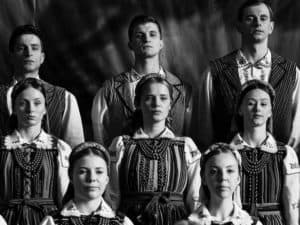 With post-war Poland still in ruins, the folkloric troupe quickly becomes a sensation. And the success of this touring musical showcase comes to the attention of the communist propogandists, who intervene with the request that more state propaganda be added to the productions. The lovers plan to escape to the West during one of the performance dates in Berlin. But fate steps in, and when they finally meet again it’s two years later in Paris, where he plays piano in smoky jazz clubs and she escapes the Iron Curtain thanks to an Italian husband.
With post-war Poland still in ruins, the folkloric troupe quickly becomes a sensation. And the success of this touring musical showcase comes to the attention of the communist propogandists, who intervene with the request that more state propaganda be added to the productions. The lovers plan to escape to the West during one of the performance dates in Berlin. But fate steps in, and when they finally meet again it’s two years later in Paris, where he plays piano in smoky jazz clubs and she escapes the Iron Curtain thanks to an Italian husband.
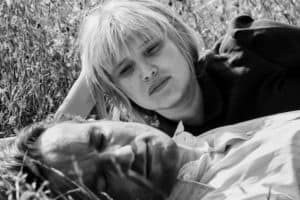 Life in exile from their beloved Poland proves to be the one pain the two cannot exorcize, as each in his and her own way keep making arrangements with the West, breaking each other’s hearts again and again, and then finding each other, again and again.
Life in exile from their beloved Poland proves to be the one pain the two cannot exorcize, as each in his and her own way keep making arrangements with the West, breaking each other’s hearts again and again, and then finding each other, again and again.
Nothing can keep them apart. Or together. And the film’s genius lies in showing us the angst of a love that, while obviously deep and true, is subject to the destructive influence of post-war ruin, the neferious Soviet surveillance system, and the mercurial personalities of the lovers themselves.
What a feast for the eyes! The two lead actors burn for each other and their wildly erratic passion seems to sear the screen itself. It is a sensuous treat to watch them storm and fight, dance, love, and weep, stricken by the depth of their feelings for each other trapped in an uneasy halfway house of history.
Pawlikow ski’s musical score is as much a player in this richly atmospheric film as is the bleak beauty of the country itself. From the haunting folk songs, collected and recorded at the start of the film so that Wiktor and his musical partner can shape the concert that Mazurk will perform, to the earthy, smoky blues and searing bebop of the jazz clubs. The sounds and blazing camerawork fuse to create scenes and moments of almost magic realist intensity.
ski’s musical score is as much a player in this richly atmospheric film as is the bleak beauty of the country itself. From the haunting folk songs, collected and recorded at the start of the film so that Wiktor and his musical partner can shape the concert that Mazurk will perform, to the earthy, smoky blues and searing bebop of the jazz clubs. The sounds and blazing camerawork fuse to create scenes and moments of almost magic realist intensity.

Stunningly shot by cinematographer Lukasz Zal (who similarly turned Pawlikowski’s Ida, into an Oscar-winning masterpiece of unflinching nostalgia.), Cold War liberates 21st century viewers from our own political maelstroms and internet-driven minutiae. It is bracing to be confronted with recent history that feels so very far away, and yet whose harrowing failures we continue to repeat.
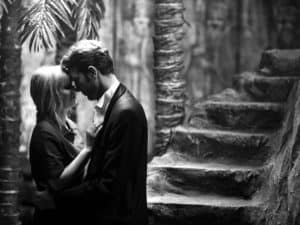
Graced by a spectacularly perfect ending, the film will break your heart.
You won’t see many films like this, and Cold War will make you rethink the dominance of color cinema. Without all the extraneous information of color footage, we are able to see Pawlikowski’s grimly beatific Poland all the more clearly. This is black and white that throbs and burns with life and color.
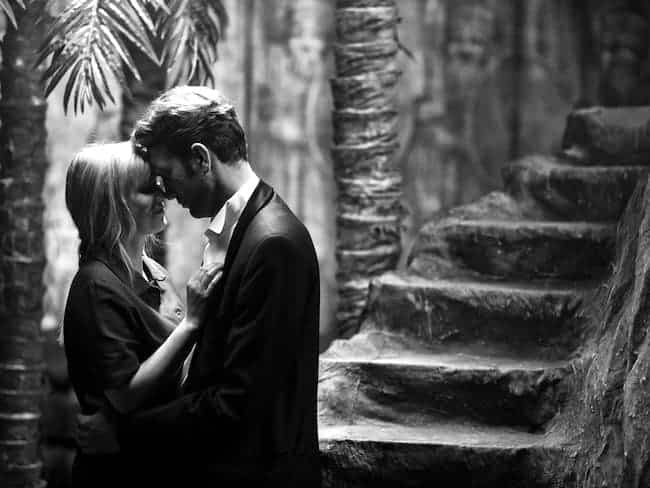
Oscars 2019: Part II
by Christina Waters | Feb 16, 2019 | Home |
Duelling Divas — my film buddy Lisa Jensen and I — continue to ponder our Oscar favorites. . .
CW: Best Cinematography.
It’s gotta be Cold War. Every moment of its eloquent visual storytelling surrounded its central characters with the bohemian allure and political ruin of their eastern european milieu. I admit I was mesmerized by the art direction in The Favourite but while engaged by the camerawork I was too aware of the use of fisheye lenses and other tricks. All of these visual devices worked to push the film’s story around without moving it foreward. If Roma starts sweeping its nominated categories, it will very likely win in this category, but having said that I have to question the softness of imagery and lack of contrast. Instead of crisp blacks and whites, Cuarón gives us fifty shades of grey. The film’s murkiness might be a metaphor for the occluded (polluted) skies of Mexico City.
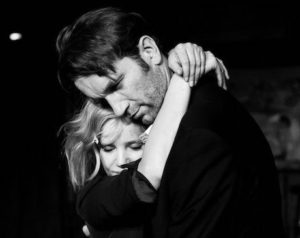 The most eloquent black and white cinematography seen in recent decades comes from Cold War’s Lukasz Zal, for his work in Pavel Pawlikowski‘s captivating cinematic love story. His astonishing eye for contrast caresses the tragic lovers in ways that convince you real life should be understood in black and white.
The most eloquent black and white cinematography seen in recent decades comes from Cold War’s Lukasz Zal, for his work in Pavel Pawlikowski‘s captivating cinematic love story. His astonishing eye for contrast caresses the tragic lovers in ways that convince you real life should be understood in black and white.
LJ: I love that two of the nominated film are in black-and-white. The technique doesn’t have to be crisp, for my money, only evocative, which Roma definitely is. Think of it as moody and pearlescent, not grey! And besides the chiaroscuro effect of black-and-white, Cuaron’s compositions are enthralling, even if it’s just water washing over a tile floor. If the Academy wants to give Spike Lee the directing nod, this award could be Cuaron’s “consolation prize.”
CW: I’ll grant you Lisa, that opening of the water on the tiles, and the plane flying overhead reflected in the water—was enthralling. As good as Bergman. But chiaroscuro Roma wasn’t. Very mise en scene, keeping the camera in one place and having life move in and out of it—that can work if there’s some authentic emotional urgency, rather than bombarding us with a string of embarrassing and/or unpleasant incidents. Just didn’t do it for me.
CW: Best Supporting Actress. Is it just me, or is Amy Adams just not much of anything? I have never been 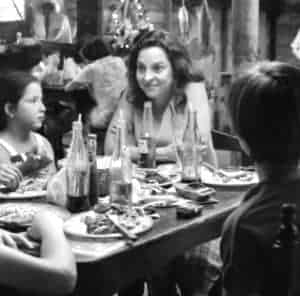 able to figure out why she is even in movies. Anything she can do, Julianne Moore or Nicole Kidman or Julia Roberts can do much better. So she’s out. Emma Stone, who was wonderful and Rachel Weisz, who can do no wrong, cancelled each other out in the sense that they were both equally terrific in roles that literally supported the fabulous Olivia Coleman’s Queen Anne. My money’s on the memorable Marina de Tavira, who helped give depth and emotional shape to Roma.
able to figure out why she is even in movies. Anything she can do, Julianne Moore or Nicole Kidman or Julia Roberts can do much better. So she’s out. Emma Stone, who was wonderful and Rachel Weisz, who can do no wrong, cancelled each other out in the sense that they were both equally terrific in roles that literally supported the fabulous Olivia Coleman’s Queen Anne. My money’s on the memorable Marina de Tavira, who helped give depth and emotional shape to Roma.
LJ: I haven’t seen If Beale Steet Could Talk, or Vice yet, so I can’t comment on Regina King or Amy Adams’ chances. I don’t necessarily think Stone and Weiss cancel each other out because they’re both nominated for the same movie, but they both have recently won Oscars (Stone for La La Land, just two years ago), so probably will not be seen as due for another one so soon. I agree, Maria de Tavira has the inside track here, especially if Roma cleans up in other categories.
CW: Best Supporting Actor. Sam Rockwell is a sly fox and he was a great George W. Bush in Vice. But again, I felt it was more impersonation. He gave us an original character in Three Billboards.  And since I can’t comment on Adam Driver, the ever-perfect, never-won-an-Oscar Sam Elliott, or Richard E Grant, I’ll go with the elegant Mahershala Ali, who made the perfect foil for Viggo, and vice versa. Those two had chemistry to burn. Plus Ali just won the Screen Actor’s Guild award for this part.
And since I can’t comment on Adam Driver, the ever-perfect, never-won-an-Oscar Sam Elliott, or Richard E Grant, I’ll go with the elegant Mahershala Ali, who made the perfect foil for Viggo, and vice versa. Those two had chemistry to burn. Plus Ali just won the Screen Actor’s Guild award for this part.
LJ: Sam Rockwell is out, only because he won in this category last year in Three Billboards. Mahershala Ali won two years ago (and deservedly so) in Moonlight. It’s funny that Adam Driver is nominated in the supporting category when his co-star, John David Washington (who played the black Klansman of the title) was passed over for a Best Actor nomination.
On the other hand, Richard E. Grant was great, caustic, slinky fun in Can You Ever Forgive Me? I don’t think his co-star, Melissa McCarthy will win for Best Actress (she’s de-glamorized in every movie she’s in), but the movie’s insider’s look at literary shenanigans might have enough partisans to tip the gold to Grant.the most reliable character actors in the biz — with perhaps the most distinctive voice — Elliott is overdue for an accoldade, and the high-profile A Star Is Born could be his E ticket.
 CW: Best Film Editing—I’d have to go with Bohemian Rhapsody on this. Seamless movement through time, space, and emotional volume as the camera shifted perfectly from Mercury’s anxieties to edgy rehearsals and up onto the stage itself, offering us the strutting Highness of Queen, as well as the adoring audiences responding. Fabulous immersion into Mercury’s ascent, decline, and legacy.
CW: Best Film Editing—I’d have to go with Bohemian Rhapsody on this. Seamless movement through time, space, and emotional volume as the camera shifted perfectly from Mercury’s anxieties to edgy rehearsals and up onto the stage itself, offering us the strutting Highness of Queen, as well as the adoring audiences responding. Fabulous immersion into Mercury’s ascent, decline, and legacy.
LJ: Um, I never actually notice film editing, unless it’s so clunky, it stops the action cold. As long as the picture keeps moving, I’m happy!
CW: Lisa! I’m shocked. Editing is what propels, or slows, or fixes the narrative arc of a film. Quick cuts move us swiftly, back and forth in time, in and out of a character’s stream of consciousness. The fixed camera forces us to watch the action in real time, creating a whole new rhythm to the storytelling, e.g. Antonioni’s slow, granular vistas as opposed to any one of the James Bond action flicks.
Okay, so how are we feeling about Sound, Costumes, and Screenplays? Stay tuned for our final Oscar installment from Duelling Divas, Christina Waters and Lisa Jensen.
And as a parenthetical note, the Academy has reversed its initial (and utterly lame) announcement to give awards for non-celebrity-filled categories such as Cinematography, Costumes, Screenplays, etc. during commercial breaks at the Oscars on February 24. Whew!

Oscars 2019! Part I
by Christina Waters | Jan 31, 2019 | Home |
 I chat with GTWeekly film critic Lisa Jensen about the Oscar nominations.
I chat with GTWeekly film critic Lisa Jensen about the Oscar nominations.
CW: Hey there Lisa—well I have to say of this list of eight nominees for Best Picture this year, I have seen only 5 (five!).
Bohemian Rhapsody—heart-pounding music and attitude; Roma—languid, real-time memoir; The Favourite—visceral history lesson with three powerful dames; Green Book—crisp storytelling with appealing characters; and Vice—gritty and ugly underbelly of politics.
Didn’t see: Black Panther, A Star is Born, or BlacKkKlansman, all three of which left town before I had a chance to check them out. So I’m going to be clueless about Spike Lee’s long overdue Oscar nomination, as well as the Marvel Comics saga, and whether or not Lady Gaga is the star that was born.
Any comments about this lineup of nominees?
LJ: Black Panther was a helluva lot of fun (although my favorite Straight Outta Oakland movie of the year was the exceptional Blindspotting). (Actually, it’s my favorite movie of the year, period.) I think the main thing you can see from this list is that Academy voters were trying to support diversity of themes, cultures, and styles in their nominees.
 Only A Star Is Born is the kind of old-fashioned manstream melodrama that Hollywood always used to recognize with Oscar nominations —pretty much to the exclusion of any other kind of movie.
Only A Star Is Born is the kind of old-fashioned manstream melodrama that Hollywood always used to recognize with Oscar nominations —pretty much to the exclusion of any other kind of movie.
I too missed BlacKkKlansman, but if it has an iota of the wit and audacity of Lee’s best (Do The Right Thing or She’s Gotta Have It), it’ll be a worthy contender.
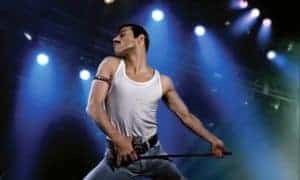 I loved Bohemian Rhapsody, Queen nut that I am, but I’m surprised it’s getting so much year-end awards attention. (But not displeased.) Despite—or possibly because of—its slow beginning, Roma really touched me as a mood piece about stillness and observation and being present in the journey of life. Green Book was highly entertaining, thanks to well-matched co-stars Viggo Mortensen and Mahershala Ali, and I’ll bet Vice is a riot, in its own weird way, although I haven’t caught up with it yet.
I loved Bohemian Rhapsody, Queen nut that I am, but I’m surprised it’s getting so much year-end awards attention. (But not displeased.) Despite—or possibly because of—its slow beginning, Roma really touched me as a mood piece about stillness and observation and being present in the journey of life. Green Book was highly entertaining, thanks to well-matched co-stars Viggo Mortensen and Mahershala Ali, and I’ll bet Vice is a riot, in its own weird way, although I haven’t caught up with it yet.
The Favourite is the only nominee I question on the list. All three lead actresses were terrific, but I don’t understand why Yorgos Lanthimos has a career, or what he’s trying to do with it.
CW: As I watched the very stylish, postmodern, and over-the-top The Favourite I 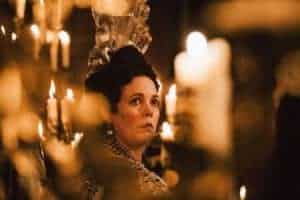 realized quickly that I was watching Olivia Coleman win the Best Actress Oscar. Her daring, generous, and courageous performance, throwing herself into the least flattering situations and camera angles, all the while moving with lightening speed from despair to delight, was a tour de force. And while I agree with you that Lanthimos’ filmography is beyond weird, the performances definitely held my attention. No holds barred as far as the three female characters/actors went.
realized quickly that I was watching Olivia Coleman win the Best Actress Oscar. Her daring, generous, and courageous performance, throwing herself into the least flattering situations and camera angles, all the while moving with lightening speed from despair to delight, was a tour de force. And while I agree with you that Lanthimos’ filmography is beyond weird, the performances definitely held my attention. No holds barred as far as the three female characters/actors went.
LJ: I agree about Olivia Coleman; she was absolutey fearless in staying true to her cranky, sad-sack character, no matter how awful she looked onscreen — and that’s the kind of anti-glam riskiness that wins Oscar votes. (Just ask Charlize Theron or Nicole Kidman.) She was also brilliant in creating the only character in this very mannered and peculiar movie viewers could possibly care about, in all her imperious vulnerability.
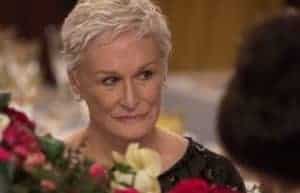 But let’s not count out Glenn Close. After a high-profile career full of nominations, she has yet to be the bride. Whatever might be said about The Wife, it might simply be Close’s turn.
But let’s not count out Glenn Close. After a high-profile career full of nominations, she has yet to be the bride. Whatever might be said about The Wife, it might simply be Close’s turn.
CW: Yes, it’s high time Close won (even though I hope that Coleman gets it), and her recent SAG award tends to point her toward an Oscar.
LJ: Also, pay attention to Yalitza Aparicio, who is living the Star-Is-Born dream in real life as an unknown getting the lead in Roma. If the multi-nominated Roma shows signs of sweeping, her chances are excellent.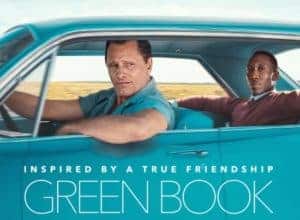
CW: Can’t agree with you about this performance. The director seemed to insist that we be impressed, and often with Roma I felt manipulated.
The Best Actor category seems more closely matched. Viggo Mortensen was fantastic as the loud, crude, decent blue collar driver—he embedded himself in this role and clearly had a great time with it. It showed Viggo’s oft-overlooked depth as a resourceful actor.
 Willem Dafoe was so obviously acting, and while I love him (or perhaps I should say I love looking at him—the teeth, and jaw, and wild eyes), he didn’t convince me. And he was the best thing about this moronic home movie by a spoiled artist. Christian Bale was spot on as Dick Cheney, but I felt as though I were watching a reenactment rather than a creative interpretation, whereas Rami Malek, as Freddie Mercury seemed to illuminate the man, the insecure boy looking for love, and ultimately the consummate rock star. Maybe I was just rocked by the music, but that last scene at the Live Aid concert was as good as music film gets.
Willem Dafoe was so obviously acting, and while I love him (or perhaps I should say I love looking at him—the teeth, and jaw, and wild eyes), he didn’t convince me. And he was the best thing about this moronic home movie by a spoiled artist. Christian Bale was spot on as Dick Cheney, but I felt as though I were watching a reenactment rather than a creative interpretation, whereas Rami Malek, as Freddie Mercury seemed to illuminate the man, the insecure boy looking for love, and ultimately the consummate rock star. Maybe I was just rocked by the music, but that last scene at the Live Aid concert was as good as music film gets.
 So Rami Malek gets my vote as winner. And there seems to be some momentum in his favor.
So Rami Malek gets my vote as winner. And there seems to be some momentum in his favor.
LJ: Rami Malek was outstanding; he inhabited Freddie Mercury right down to the prosthetic overbite! I love Willem Dafoe too, but the despairing angst with which he was encouraged to chew his way through the horribly misbegotten At Eternity’s Gate will probably not be mistaken for a great performance by Academy voters.Besides, only 12 people in the world saw the movie, including you and me, and we’re not voting. Meanwhile, Mortensen could cruise to gold as a genial, blue-collar shmo who discovers, and then rises above, his own racism in Green Book. (He also packed on 40 pounds for the role, the male equivalent of an actress deglamorizing herself, by Oscar standards.)
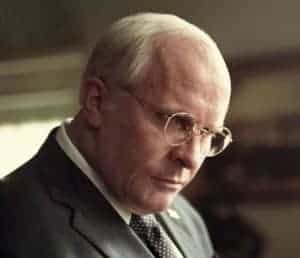 But I can’t help but think that Academy voters might go for Christian Bale, a chameleon who physically remakes himself for every role. The politics of Vice align with a large percentage of Hollywood and its Oscar voters. And who wouldn’t be seduced by Bale’s acceptance speech at the Globes, where he thanked Satan for giving him the inspiration to play Dick Cheney?
But I can’t help but think that Academy voters might go for Christian Bale, a chameleon who physically remakes himself for every role. The politics of Vice align with a large percentage of Hollywood and its Oscar voters. And who wouldn’t be seduced by Bale’s acceptance speech at the Globes, where he thanked Satan for giving him the inspiration to play Dick Cheney?
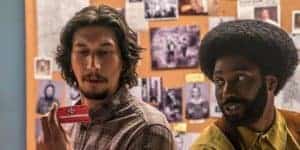 CW: Best Director: I realize there will be some serious momentum for Spike Lee for what is incredibly only his first nomination. Unfortunately he’s up against auteur Alfonso Cuarón, whose Roma was a poetic memoir of his own childhood. The Academy adores that kind of stuff. He wrote, produced, photographed, and directed this black and white elegy. But I didn’t love the film. There was something missing, that something that kindles rather than insists upon my empathy. The film did not touch me. But I absolutely appreciate the scope of his ambition here. And I think he will take the Oscar.
CW: Best Director: I realize there will be some serious momentum for Spike Lee for what is incredibly only his first nomination. Unfortunately he’s up against auteur Alfonso Cuarón, whose Roma was a poetic memoir of his own childhood. The Academy adores that kind of stuff. He wrote, produced, photographed, and directed this black and white elegy. But I didn’t love the film. There was something missing, that something that kindles rather than insists upon my empathy. The film did not touch me. But I absolutely appreciate the scope of his ambition here. And I think he will take the Oscar.
LJ: I’m just tickled that two of the five directors are nominated for foreign-language films—unusual in Oscar history (if one is not named Fellini). Cuaron already has an impressive Hollywood track record (from Y Tu Mama Tambien to the third Harry Potter movie, to Children Of Men). So he might have an edge here, even though he already has a directing Oscar for Gravity.
I agree that Lee’s chances are excellent in his first-ever directing nomination—far better than Adam McKay’s for Vice, making an irreverent comedy out of the Bush/Cheney moment in American politics. And I continue to be mystified by the Svengali-like hold that Yorgos Lanthimos exerts over the moviegoing public, especially critics. I passionately hated his breakout movie, The Lobster, for its mean-spirited cruelty in the name of satire, and the smug, farcical, slapstick tone of The Favourite just eludes me. I don’t get it.
**********************
Stay tuned for our continuing conversation as we hash out the remaining Oscar nominations, including Supporting Actors, Cinematography, and Editing. All in time for the Oscars on Sunday February 24.

 Before you know it the Kims, who’ll literally do anything to make money, manage to insinuate themselves into the heart of the Park’s splendid household. It is a symbiotic ecosystem made in the hellishly brilliant imagination of this director.
Before you know it the Kims, who’ll literally do anything to make money, manage to insinuate themselves into the heart of the Park’s splendid household. It is a symbiotic ecosystem made in the hellishly brilliant imagination of this director.
 The house itself is a key player in what will reveal itself to be Bong’s sly-handed tale of social inequity. An architectural masterpiece (designed by director Bong and made especially for the film) the sleek modernist house is laid out in interlocking levels. The living room’s enormous wall of glass overlooks an oasis of green lawn bordered by a manicured hedge.
The house itself is a key player in what will reveal itself to be Bong’s sly-handed tale of social inequity. An architectural masterpiece (designed by director Bong and made especially for the film) the sleek modernist house is laid out in interlocking levels. The living room’s enormous wall of glass overlooks an oasis of green lawn bordered by a manicured hedge.  This hermetic world insulates the Parks from any unsightly social reality and makes a painful contrast to the mess and chaos of the Kim’s basement apartment. Most importantly to the director’s storytelling, the house also contains a secret passage into yet another domain—and a ghastly secret buried deep within the heart of lavish wealth.
This hermetic world insulates the Parks from any unsightly social reality and makes a painful contrast to the mess and chaos of the Kim’s basement apartment. Most importantly to the director’s storytelling, the house also contains a secret passage into yet another domain—and a ghastly secret buried deep within the heart of lavish wealth.
 And once the shocking visual pyrotechnics have cooled down, the film draws to a haunting, eloquent close a la Charles Dickens. Desperate and ephemeral dreams, of the sort that reveal how much the rich and the poor are mutually bound in a slow dance of need, greed, hypocrisy, and desire.
And once the shocking visual pyrotechnics have cooled down, the film draws to a haunting, eloquent close a la Charles Dickens. Desperate and ephemeral dreams, of the sort that reveal how much the rich and the poor are mutually bound in a slow dance of need, greed, hypocrisy, and desire.



 It’s worth noting that Tarantino’s loveletter to an America gone (and which existed only for some) also grieves for values currently in decline in 21st century America. In a recent op-ed piece Maureen Dowd observed that “
It’s worth noting that Tarantino’s loveletter to an America gone (and which existed only for some) also grieves for values currently in decline in 21st century America. In a recent op-ed piece Maureen Dowd observed that “ After the end of long days on the set—days in which Dalton is getting fewer parts, and Booth is given fewer stunt gigs—Booth drives Dalton back to Cielo Drive in the Caddie, and then hops into his own battered Karmann Ghia for the long commute back to his airstream trailer in Van Nuys.
After the end of long days on the set—days in which Dalton is getting fewer parts, and Booth is given fewer stunt gigs—Booth drives Dalton back to Cielo Drive in the Caddie, and then hops into his own battered Karmann Ghia for the long commute back to his airstream trailer in Van Nuys. So we meet Sharan Tate while her husband is out of the country, and she and her former boyfriend (now constant companion) Jay Sebring (Emile Hirsch) go out to all the parties. Tarantino’s portrait of Tate is as a glowing, all-American beauty enchanted by her own good fortune, good looks, and not much else. She flits, and dances, and skips through Westwood Village, even stopping in a theater to catch a screening of her latest film, squealing with excitement at the sight of herself on the screen. The film’s soundtrack, and settings, plunge us into a made-for-Hollywood fantasy of Hollywood itself. Over-the-top eye candy. Just enjoy it. Meanwhile, Tarantino is an adolescent indulging his own fantasies, of Hollywood, of the 60s and of what might have happened one fateful night.
So we meet Sharan Tate while her husband is out of the country, and she and her former boyfriend (now constant companion) Jay Sebring (Emile Hirsch) go out to all the parties. Tarantino’s portrait of Tate is as a glowing, all-American beauty enchanted by her own good fortune, good looks, and not much else. She flits, and dances, and skips through Westwood Village, even stopping in a theater to catch a screening of her latest film, squealing with excitement at the sight of herself on the screen. The film’s soundtrack, and settings, plunge us into a made-for-Hollywood fantasy of Hollywood itself. Over-the-top eye candy. Just enjoy it. Meanwhile, Tarantino is an adolescent indulging his own fantasies, of Hollywood, of the 60s and of what might have happened one fateful night. The scenes of the Spahn Movie Ranch, owned by an old friend of Booth’s, where the Manson Family has decamped feel chillingly authentic. Nothing short of Sergio Leone-meets-David Lynch is the surrealistic atmosphere of Pitt accidentally meeting the Manson family for the first time. When he returns from checking in on old man Spahn he discovers that his car tire has been flattened, and in “persuading” the bad guy to fix the tire he’s damaged, we first see what stunt man Booth is truly capable of. It’s frankly shocking, all the more so since it’s the warm persona of Brad Pitt’s character that suddenly reveals what’s beneath.
The scenes of the Spahn Movie Ranch, owned by an old friend of Booth’s, where the Manson Family has decamped feel chillingly authentic. Nothing short of Sergio Leone-meets-David Lynch is the surrealistic atmosphere of Pitt accidentally meeting the Manson family for the first time. When he returns from checking in on old man Spahn he discovers that his car tire has been flattened, and in “persuading” the bad guy to fix the tire he’s damaged, we first see what stunt man Booth is truly capable of. It’s frankly shocking, all the more so since it’s the warm persona of Brad Pitt’s character that suddenly reveals what’s beneath. The entire film taxes the viewer’s patience as much as it strains even fairytale credulity. But there are scenes to savor that make the experience well worth while (keep in mind Pitt’s abs).
The entire film taxes the viewer’s patience as much as it strains even fairytale credulity. But there are scenes to savor that make the experience well worth while (keep in mind Pitt’s abs).
 CW: Makeup and Hair: Well it HAS to be Vice for its miraculous transformation of some fine actors—especially Steve Carell, Christian Bale and Sam Rockwell—into some of the highest profile politicos in the 20th century.
CW: Makeup and Hair: Well it HAS to be Vice for its miraculous transformation of some fine actors—especially Steve Carell, Christian Bale and Sam Rockwell—into some of the highest profile politicos in the 20th century.
 LJ: Black Panther all the way for me. The rich Tribal-Meets-Techno vibe created by Ruth E. Carter was eye-popping, fun, and so smart! Whereas, The Favourite costumes looked slightly fake to me, like costumes you make for the Renaissance Faire with store-bought materials like rick-rack instead of elaborate period embroidery. But, intentionally fake, like everyone in the movie was in on a big joke, and they were all sniggering behind their fans at the absurdity of it all.
LJ: Black Panther all the way for me. The rich Tribal-Meets-Techno vibe created by Ruth E. Carter was eye-popping, fun, and so smart! Whereas, The Favourite costumes looked slightly fake to me, like costumes you make for the Renaissance Faire with store-bought materials like rick-rack instead of elaborate period embroidery. But, intentionally fake, like everyone in the movie was in on a big joke, and they were all sniggering behind their fans at the absurdity of it all.

 The lovers first make an electrifying connection when the young blonde Zula auditions for a Polish folksong and dance troupe, Mazurk, training to begin a tour of Eastern European cities. Wiktor (Tomasz Kot) is one of the music instructors, and when he hears Zula (Joanna Kulig) audition he is immediately drawn to her bright energy. She is as sensuous as he is brooding. But as he quickly learns, she has a checkered past, and uses the musical ensemble as a means of escape into a more exciting life.
The lovers first make an electrifying connection when the young blonde Zula auditions for a Polish folksong and dance troupe, Mazurk, training to begin a tour of Eastern European cities. Wiktor (Tomasz Kot) is one of the music instructors, and when he hears Zula (Joanna Kulig) audition he is immediately drawn to her bright energy. She is as sensuous as he is brooding. But as he quickly learns, she has a checkered past, and uses the musical ensemble as a means of escape into a more exciting life. With post-war Poland still in ruins, the folkloric troupe quickly becomes a sensation. And the success of this touring musical showcase comes to the attention of the communist propogandists, who intervene with the request that more state propaganda be added to the productions. The lovers plan to escape to the West during one of the performance dates in Berlin. But fate steps in, and when they finally meet again it’s two years later in Paris, where he plays piano in smoky jazz clubs and she escapes the Iron Curtain thanks to an Italian husband.
With post-war Poland still in ruins, the folkloric troupe quickly becomes a sensation. And the success of this touring musical showcase comes to the attention of the communist propogandists, who intervene with the request that more state propaganda be added to the productions. The lovers plan to escape to the West during one of the performance dates in Berlin. But fate steps in, and when they finally meet again it’s two years later in Paris, where he plays piano in smoky jazz clubs and she escapes the Iron Curtain thanks to an Italian husband. Life in exile from their beloved Poland proves to be the one pain the two cannot exorcize, as each in his and her own way keep making arrangements with the West, breaking each other’s hearts again and again, and then finding each other, again and again.
Life in exile from their beloved Poland proves to be the one pain the two cannot exorcize, as each in his and her own way keep making arrangements with the West, breaking each other’s hearts again and again, and then finding each other, again and again. ski’s musical score is as much a player in this richly atmospheric film as is the bleak beauty of the country itself. From the haunting folk songs, collected and recorded at the start of the film so that Wiktor and his musical partner can shape the concert that Mazurk will perform, to the earthy, smoky blues and searing bebop of the jazz clubs. The sounds and blazing camerawork fuse to create scenes and moments of almost magic realist intensity.
ski’s musical score is as much a player in this richly atmospheric film as is the bleak beauty of the country itself. From the haunting folk songs, collected and recorded at the start of the film so that Wiktor and his musical partner can shape the concert that Mazurk will perform, to the earthy, smoky blues and searing bebop of the jazz clubs. The sounds and blazing camerawork fuse to create scenes and moments of almost magic realist intensity.


 The most eloquent black and white cinematography seen in recent decades comes from Cold War’s Lukasz Zal, for his work in Pavel Pawlikowski‘s captivating cinematic love story. His astonishing eye for contrast caresses the tragic lovers in ways that convince you real life should be understood in black and white.
The most eloquent black and white cinematography seen in recent decades comes from Cold War’s Lukasz Zal, for his work in Pavel Pawlikowski‘s captivating cinematic love story. His astonishing eye for contrast caresses the tragic lovers in ways that convince you real life should be understood in black and white. able to figure out why she is even in movies. Anything she can do, Julianne Moore or Nicole Kidman or Julia Roberts can do much better. So she’s out. Emma Stone, who was wonderful and Rachel Weisz, who can do no wrong, cancelled each other out in the sense that they were both equally terrific in roles that literally supported the fabulous Olivia Coleman’s Queen Anne. My money’s on the memorable Marina de Tavira, who helped give depth and emotional shape to Roma.
able to figure out why she is even in movies. Anything she can do, Julianne Moore or Nicole Kidman or Julia Roberts can do much better. So she’s out. Emma Stone, who was wonderful and Rachel Weisz, who can do no wrong, cancelled each other out in the sense that they were both equally terrific in roles that literally supported the fabulous Olivia Coleman’s Queen Anne. My money’s on the memorable Marina de Tavira, who helped give depth and emotional shape to Roma. And since I can’t comment on Adam Driver, the ever-perfect, never-won-an-Oscar Sam Elliott, or Richard E Grant, I’ll go with the elegant Mahershala Ali, who made the perfect foil for Viggo, and vice versa. Those two had chemistry to burn. Plus Ali just won the Screen Actor’s Guild award for this part.
And since I can’t comment on Adam Driver, the ever-perfect, never-won-an-Oscar Sam Elliott, or Richard E Grant, I’ll go with the elegant Mahershala Ali, who made the perfect foil for Viggo, and vice versa. Those two had chemistry to burn. Plus Ali just won the Screen Actor’s Guild award for this part. CW: Best Film Editing—I’d have to go with Bohemian Rhapsody on this. Seamless movement through time, space, and emotional volume as the camera shifted perfectly from Mercury’s anxieties to edgy rehearsals and up onto the stage itself, offering us the strutting Highness of Queen, as well as the adoring audiences responding. Fabulous immersion into Mercury’s ascent, decline, and legacy.
CW: Best Film Editing—I’d have to go with Bohemian Rhapsody on this. Seamless movement through time, space, and emotional volume as the camera shifted perfectly from Mercury’s anxieties to edgy rehearsals and up onto the stage itself, offering us the strutting Highness of Queen, as well as the adoring audiences responding. Fabulous immersion into Mercury’s ascent, decline, and legacy.
 I chat with GTWeekly film critic
I chat with GTWeekly film critic  Only A Star Is Born is the kind of old-fashioned manstream melodrama that Hollywood always used to recognize with Oscar nominations —pretty much to the exclusion of any other kind of movie.
Only A Star Is Born is the kind of old-fashioned manstream melodrama that Hollywood always used to recognize with Oscar nominations —pretty much to the exclusion of any other kind of movie. I loved Bohemian Rhapsody, Queen nut that I am, but I’m surprised it’s getting so much year-end awards attention. (But not displeased.) Despite—or possibly because of—its slow beginning, Roma really touched me as a mood piece about stillness and observation and being present in the journey of life. Green Book was highly entertaining, thanks to well-matched co-stars Viggo Mortensen and Mahershala Ali, and I’ll bet Vice is a riot, in its own weird way, although I haven’t caught up with it yet.
I loved Bohemian Rhapsody, Queen nut that I am, but I’m surprised it’s getting so much year-end awards attention. (But not displeased.) Despite—or possibly because of—its slow beginning, Roma really touched me as a mood piece about stillness and observation and being present in the journey of life. Green Book was highly entertaining, thanks to well-matched co-stars Viggo Mortensen and Mahershala Ali, and I’ll bet Vice is a riot, in its own weird way, although I haven’t caught up with it yet. realized quickly that I was watching Olivia Coleman win the Best Actress Oscar. Her daring, generous, and courageous performance, throwing herself into the least flattering situations and camera angles, all the while moving with lightening speed from despair to delight, was a tour de force. And while I agree with you that Lanthimos’ filmography is beyond weird, the performances definitely held my attention. No holds barred as far as the three female characters/actors went.
realized quickly that I was watching Olivia Coleman win the Best Actress Oscar. Her daring, generous, and courageous performance, throwing herself into the least flattering situations and camera angles, all the while moving with lightening speed from despair to delight, was a tour de force. And while I agree with you that Lanthimos’ filmography is beyond weird, the performances definitely held my attention. No holds barred as far as the three female characters/actors went. But let’s not count out Glenn Close. After a high-profile career full of nominations, she has yet to be the bride. Whatever might be said about The Wife, it might simply be Close’s turn.
But let’s not count out Glenn Close. After a high-profile career full of nominations, she has yet to be the bride. Whatever might be said about The Wife, it might simply be Close’s turn.
 Willem Dafoe was so obviously acting, and while I love him (or perhaps I should say I love looking at him—the teeth, and jaw, and wild eyes), he didn’t convince me. And he was the best thing about this
Willem Dafoe was so obviously acting, and while I love him (or perhaps I should say I love looking at him—the teeth, and jaw, and wild eyes), he didn’t convince me. And he was the best thing about this  But I can’t help but think that Academy voters might go for Christian Bale, a chameleon who physically remakes himself for every role. The politics of Vice align with a large percentage of Hollywood and its Oscar voters. And who wouldn’t be seduced by Bale’s acceptance speech at the Globes, where he thanked Satan for giving him the inspiration to play Dick Cheney?
But I can’t help but think that Academy voters might go for Christian Bale, a chameleon who physically remakes himself for every role. The politics of Vice align with a large percentage of Hollywood and its Oscar voters. And who wouldn’t be seduced by Bale’s acceptance speech at the Globes, where he thanked Satan for giving him the inspiration to play Dick Cheney? CW: Best Director: I realize there will be some serious momentum for Spike Lee for what is incredibly only his first nomination. Unfortunately he’s up against auteur Alfonso Cuarón, whose Roma was a poetic memoir of his own childhood. The Academy adores that kind of stuff. He wrote, produced, photographed, and directed this black and white elegy. But I didn’t love the film. There was something missing, that something that kindles rather than insists upon my empathy. The film did not touch me. But I absolutely appreciate the scope of his ambition here. And I think he will take the Oscar.
CW: Best Director: I realize there will be some serious momentum for Spike Lee for what is incredibly only his first nomination. Unfortunately he’s up against auteur Alfonso Cuarón, whose Roma was a poetic memoir of his own childhood. The Academy adores that kind of stuff. He wrote, produced, photographed, and directed this black and white elegy. But I didn’t love the film. There was something missing, that something that kindles rather than insists upon my empathy. The film did not touch me. But I absolutely appreciate the scope of his ambition here. And I think he will take the Oscar.
